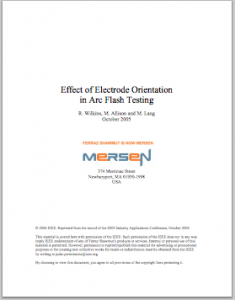Mersen’s Effect of Electrode Orientation in Arc Flash Testing white paper discusses results of testing using the IEE 1584 (the 2002 standard for arc flash hazard analysis) arc flash hazard calculation test set-up with both vertical and horizontal electrodes. High-speed videography and incident energy measurements show that the arc flash hazard is much worse with horizontal orientation. However, based on the testing current-limiting fuses were found to be effective in limiting the incident energy, even in worst-case arcing conditions, provided that the bolted-fault current is high enough to cause them to operate in their current-limiting mode.
Excerpt:
The IEEE 1584TM-2002 standard for arc flash hazard analysis [1] gives calculation methods for the determination of arcing current and incident energy density, which can be used to determine the flash boundary distance and/or the level of PPE required when working within this distance. The equations proposed are based on test data obtained with the 3-phase arcing electrodes arranged in a vertical plane and pointing downwards, while the calorimeters used to measure the incident energy were mounted at right angles to this plane. Some tests were done in open air while others were done in metal boxes with one side open, to represent electrical equipment with the door open.
Magnetic forces cause the arcs to be driven away from the source of supply, and for vertical electrodes this will be downwards. Stokes and Sweeting [2] have criticized the use of this arrangement on the grounds that the calorimeters, being “off-axis”, will mainly pick up radiated energy from the arcs, and this does not represent the worst case. They used long 3-phase arcing electrodes pointing away from the supply and towards the calorimeters. High-speed videography showed…>>Read More

